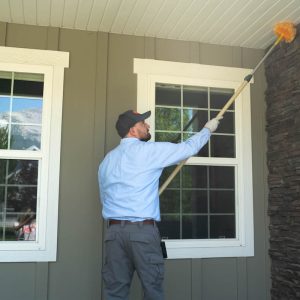Kiwis may be under the impression that termites are the only insects that are damaging to wood when in reality, they don’t deserve all the credit. Wood borers are various beetle species that bore themselves into wood, with the larvae causing the real damage. Pests have come to coexist with humanity for centuries, and in and in sharing habitats with them, we also share resources with them. Wood borers make their homes in the very same wood that make up the infrastructure of our homes and business.
Borer control, which encapsulates both management and prevention methods, is an important part of protecting the investment potential of your residential or commercial property. Let’s find out just what makes the wood borer such a headache for property owners.
New Zealand’s Most Common Wood Borer Species
New Zealand is home to 7 species of borer. The most common ‒ the Common House Borer and the Two Toothed Longhorn Borer ‒ are found in furniture and building infrastructure.
Common House Borer: Common House Borer infestations are identifiable by (2-4mm) flight holes on wooden surfaces accompanied by tiny mounds of fine sawdust. What makes the common house borer problematic is its reproductive cycle. Females lay up to 100 eggs at a time in bare wood or in previous borer holes. Eggs incubate for 4-5 weeks, and the larvae burrow into the wood, where they can live and eat for up to four years.
Unfortunately, wood borers have a penchant for soft and untreated timbers, commonly found on construction sites or timber yards, where they bore in and only make themselves known only weeks, months or years later. They pupate and emerge by boring small flight holes in the wood to continue the reproductive cycle. Adult borers are generally airborne between November and March.
Two Toothed Longhorn Borer: These native wood borers leave flight holes of up to 7 millimetres in diameter and are more oval in form. They can stay burrowed in wood for up to 11 years before emerging, meaning the damage they can cause is extensive, necessitating wood replacement. Although not as commonly found in homes as the ever so aptly named common house borer, they are more often found in the bush. They have been known to cause extensive structural damage to live trees, making them a cause for concern within the agricultural sector.
Natures Self Destruct Mechanism
The damage dealt to interior surfaces (such as door frames, window sills and architraves) is generally minor, and only the presence of exit holes detracts from the overall aesthetic. But the damage in structural areas of a building, such as the timbers in the roof void and subfloor is a great cause for concern. Heavy infestations will weaken a building’s structural integrity if not identified or adequately managed. Wood borers are attracted to freshly sawn wood, making a construction site a high risk to a new home before it is even built.
Imagine investing in a new property only to have nature’s self-destruct mechanism (an undetected wood borer colony) embedded into your property structure!
Protecting Your Investment
As a landlord, you are legally obligated to provide your renters with a pest-free home at the beginning of the lease period to prevent the occurrence of pest infestations. Any money spent on repairing property damage or mitigating infestations is money that detracts from your investments.
Long-term and sustainable pest management is the best method for safeguarding a property investment value as well as the health, safety and well-being of its occupants. New tenants should be made aware of how to identify and prevent infestations.
Note that coastline holiday homes are especially susceptible to breeding as humidity softens up wood just the way borers love it best. Aging wood in the foundation structures, particularly on southern-facing parts of homes, are also an attractive prospect to the wood borer.
Wood Borer Saturation Spray
Colonies can live undetected for years in floorboards, doorframes and ceiling beams, wreaking havoc on a building’s structural integrity. Yet even presently undetected colonies can be prevented and controlled relatively quickly with pest control.
Modern pest control takes a strategic and measured approach. At The Pest Man, we use a medium-pressure saturation spraying system to apply approved wood and timber preservatives to the structural timbers within the roof-void and subfloor as an effective form of borer control.
Saturation sprays are greatly effective for protecting homes and businesses against borer infestations. The timber preservative used (Pestbor Or Timbor) contains a unique combination of physical and chemical properties that will not decompose and acts as a reproductive cycle disrupter for wood borers. It is also a great way to protect your investment property from rot and mould. Treatments are practically odourless and pose no risk to residents whatsoever.
The Pest Man offers effective borer control and property inspection. Contact us today for an obligation free quote.



